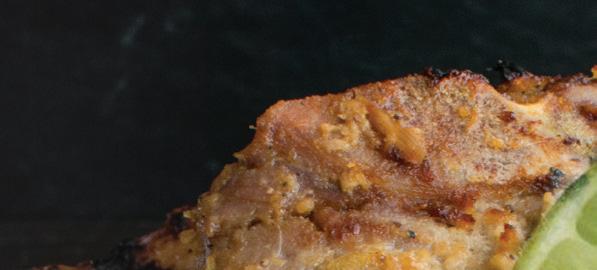
7 minute read
THE WAY TO A HEALTHY WEIGHT. How the Latino
THE WAY TO A HEALTHY WEIGHT


HOW EXPERTS AT CLARA MAASS MEDICAL CENTER ARE WORKING WITH THE LATINO COMMUNITY TO COMBAT OBESITY




“W hen I ask Latino patients when their weight started becoming a problem, they often say ‘When I came to this country,’” says Silvana Blanco, RD, a bariatric dietitian at the Weight Loss Surgery Program at Clara Maass Medical Center (CMMC).
Obesity is widespread in the U.S., affecting more than 4 in 10 people. For the Latino population, the obesity rate is slightly higher than in the general population.
Reasons for obesity in the Latino community may include a lack of knowledge, a language barrier or a lack of other resources. “In their home country, some had a daily walk to the market to pick up food for the day. Now, they may be working so many hours that they don’t have time to go for walks,” Blanco explains. “Or they may be renting a room but not have access to a kitchen. The result is that many rely on packaged and fast foods.”
Adding to the problem is the fact that Latinos have the highest uninsured rates of any group in the U.S. “Without a primary care physician, they don’t get the benefit of preventive medicine that could help head off obesity and related health issues,” says Sarah Bonilla, MPH, Director of the Center of Excellence for


HEALTHY SWITCHES FOR LATINO DISHES
INSTEAD OF THIS
Adobo spice (high in sodium)

Frying
Lard
Taco shell
Flour tortilla
Soda and other sugary drinks Beef
TRY THIS
Thyme, rosemary, pepper, Mrs. Dash salt-free seasoning Baking, grilling, air-frying, pressure cooking Olive or canola oil

Lettuce wrap Corn tortilla
Water or sparkling water Ground turkey


Latino Health (CELH) at CMMC.
“Obesity is a completely preventable disorder with nutritional education, starting with the moms and grandmas in the kitchen,” says Thomas Ortiz, MD,
Medical Director for the CELH. “For example, corn syrup in food and drinks has been a major contributor to this problem. Add this to a Latino genetic disposition to diabetes, and we have an epidemic of obesity and diabetes.” Experts at CMMC are working to meet these challenges. For example, the CELH offers blood pressure and other screenings through local churches, and has compiled a list of doctors who speak Spanish or have Spanish-speaking staff. In addition, THOMAS ORTIZ, MD the CELH off ers nutrition programs tailored for the Latino population. “We are fi nding ways to implement healthcare through nutrition,” Bonilla says.



CULTURALLY IN TUNE
Blanco and Bonilla present sessions ranging from preventing diabetes to shopping for healthy foods on a budget, using coupons from local supermarkets.
“We tell people about our programs in non-traditional ways, such as text messages and phone calls instead of emails and fl yers. We use WhatsApp for group chats,” Bonilla says. “Or we send GoToMeeting links so that people can easily log on through their phones.”
Sessions are scheduled in the evenings, to avoid working hours. Most important, the information is presented in a way that makes sense to a Latino audience.
“One of my first tasks when I came here was to translate materials into Spanish, but I found that some of the

food recommendations weren’t familiar to the Spanish-speaking population— like edamame, tofu, beef jerky and kale,” Blanco explains. “We added snacks like pepitas, roasted plaintain chips and pico de gallo with baked tortillas.” Because the Latino population is diverse, Blanco also provides lighter versions of favorite recipes from a variety of Latin American, Caribbean and South American cuisines.
The reaction to the programs has been enthusiastic. “People have so many good questions about nutrition,” says Blanco. “We have to be on our toes!”
A SURGICAL SOLUTION
Because obesity leads to pressure on joints and soft tissue, the topic often comes up in orthopedic consultations, says Nicole Lopez, MD, an orthopedic surgeon at CMMC who speaks Spanish fluently. “Some patients come in with joint complaints, or back pain, and I explain that their problems may tie back into their weight,” she explains. “Often, patients haven’t made that connection before.”
As with the general population, many Latinos find that weight loss (bariatric) surgery is the answer. “By the time patients come to us, they typically have tried a gazillion ways to lose weight, but none of them have worked,” explains Michael Cudworth, MD, a bariatric surgeon at CMMC. “Research shows that once a person’s body mass index—a measure of the relation of height to weight—is over 35 or 40, bariatric surgery is the only thing that works for sustainable weight loss.”
Dr. Cudworth, a native Spanish speaker, says that communicating in Spanish allows him to better explain the technical aspects of weight loss surgery and the elements of a healthy diet to Latino patients. “I can also explain things to their family members, and patients are so grateful for that,” he says.
“Because all systems of the body are affected by obesity, it’s critical for patients to get a handle on it,” says Dr. Lopez. “There’s no shame in it. Obesity is a medical issue and people should approach it as something to be addressed as they would any other health issue in their life.”


QUICK GARLIC-LIME MARINATED PORK CHOPS

INGREDIENTS: • 4 6-ounce lean boneless pork chops • 4 cloves garlic, crushed • ½ teaspoon cumin • ½ teaspoon chili powder • ½ teaspoon paprika • 1 teaspoon each kosher salt and fresh pepper • Juice of ½ lime • 1 teaspoon lime zest

DIRECTIONS:
• Trim fat off pork. In a large bowl, season pork with garlic, cumin, chili powder, paprika, salt and pepper. Squeeze lime juice and some zest from the lime and let it marinate at least 20 minutes. • To broil: Line broiler pan with foil for easy cleanup. Place pork chops on the broiler pan and broil about 4 to 5 minutes on each side or until browned. • To grill: Grill over medium-high heat 4 to 5 minutes on each side.




MEXICAN SHRIMP COBB SALAD


INGREDIENTS:
• 16 ounces cooked large shrimp, peeled • Chipotle chili powder to taste • 1 tablespoon lime juice plus juice of ½ lime • Salt to taste • 15 ounces black beans, rinsed and drained • 1 cup grilled corn kernels (can use frozen roasted corn) • 2 tablespoons red onion • 2 tablespoons cilantro, chopped • 6 cups romaine lettuce, shredded • 1 seedless cucumber, diced • 2 cups diced tomatoes • 1 ripe avocado, diced • 1 cup reduced fat Mexican blend shredded cheese



DIRECTIONS:
• Rinse shrimp and chop into large chunks.
Toss shrimp with chipotle chili powder, tablespoon fresh lime juice and a little salt. • Combine drained beans, corn, red onion, cilantro, juice of ½ lime and salt to taste. • In a large glass dish or clear bowl, layer salad ingredients starting with the lettuce, black bean mixture, cucumber, tomatoes, avocado, cheese and shrimp on top.



For more information about the Center of Excellence for Latino Health, call 973.450.2996 or visit www.rwjbh.org/claralatinohealth.











